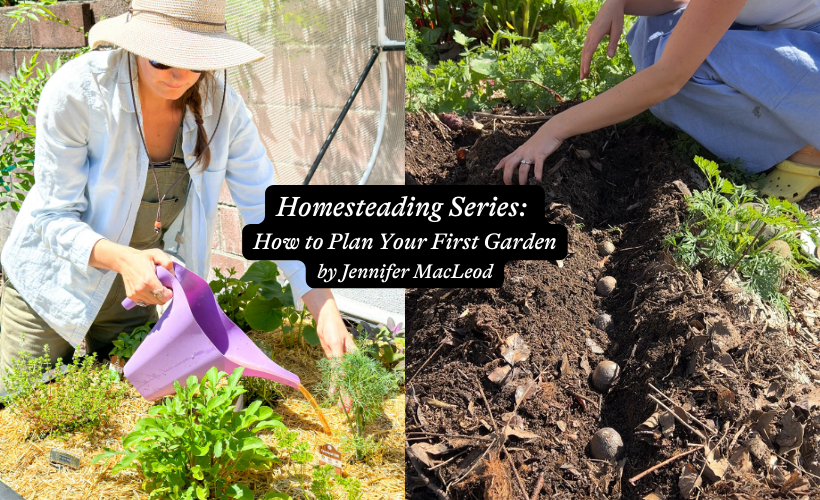

March 19, 2024
How to Plan Your First Garden
In the midst of life’s bustling pace, there’s a tranquil refuge waiting to be cultivated: your first garden. A garden is a canvas for slow, intentional living – a space where time slows and each moment is savored. But before you dig into the soil and watch your dreams take root, taking a little time to plan will ensure an easier and more successful experience. This post will outline the exact steps to take and considerations to make in planning your first garden so you can begin with confidence and harvest with abundance!
Sunlight
The first step to a successful garden is a sun study. Most veggies, fruits and herbs need full sunlight, or 6-8 hours per day, in order to thrive. Observe your space at different times of day to find the spot with the most hours of sunlight. This will be the location for your new garden!

Containers vs. In-ground
When choosing between in-ground garden beds and containers, there are some important considerations. In-ground beds offer more flexibility (you can move them easily,) cost-savings and space for plants’ roots to grow, while containers offer the ability to grow a garden in a space where you may not be able to otherwise, such as on a patio, or over very poor soil. Raised beds can also offer more accessibility by reducing the need to bend and crouch when gardening. The best choice for you will depend on your unique circumstances.

Soil Health
For a healthy garden with minimal pest and disease issues, cultivating great soil should be top priority! If you chose in-ground garden beds, you’ll want to take steps to improve and maintain the existing soil by adding compost, sheet mulching, or planting a cover crop before you plant your veggies, fruits or herbs. Waiting for the native soil to improve can be a challenge, but the gorgeous garden you’ll be able to grow is worth it! For filling containers like raised beds or pots, find a high quality planter mix you can purchase. This will likely come bagged from a local plant nursery, or in bulk from a local landscaping materials company.

Water
All plants need water! Options for keeping your plants hydrated include: relying on rainfall, hand watering with a garden hose, installing an automated drip irrigation system, and utilizing passive watering reservoirs like Ollas.

Plants
And finally, the most exciting part of starting your first garden: choosing plants! The best plants to grow in an edible garden are the ones you love to eat! Here are some beginner-friendly choices. If purchasing transplants from a nursery, try tomatoes, eggplants, peppers, basil, parsley, violas, marigolds or calendula. If you will be planting seeds directly into your garden, try: bush beans, cucumbers, pumpkins, zucchini, or yellow summer squash.

As you begin your gardening journey, remember it’s not just plants you are tending: you are also nurturing yourself. With patience and mindfulness, your garden will flourish and become a sanctuary to enjoy the simple wonders of life. So take a deep breath, dig your hands into the soil, and let the beauty of slow living bloom in every corner of your garden.
Words and photographs by Jennifer MacLeod


